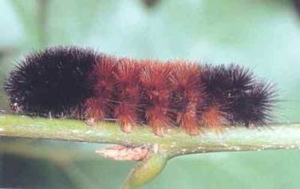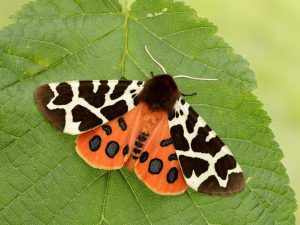
It felt like an invasion: Fuzzy black caterpillars seemed to be affixed to every stalk of blue curls in my garden. Suddenly, I had a flashback to a day when I was seven years old, and I was sitting in my neighbor Nora’s treehouse. I put my hand down on the wood to brace myself and felt a pain unlike any that I’d felt before. It was an asp. Was that what these fuzzy, fat caterpillars were?
They weren’t. No, the black balls of fluff that seemed to be everywhere this spring were salt marsh or tiger moth caterpillars, also known as woolly bears—and that for an obvious reason.
Actually, the term “woolly bear” is used to refer to any number of black fuzzy caterpillars, chiefly the salt marsh caterpillar, the garden tiger moth caterpillar, and the Isabella tiger moth caterpillar here in Texas. What’s the difference? According to Texas A&M AgriLife, “The saltmarsh caterpillar ranges in color from black to brown to yellowish, while the garden tiger moth caterpillar has a fuzzy black top and brown bottom.” The Isabella tiger moth caterpillar, in contrast, is black at the front and back ends, with reddish brown in the middle.
People with more sensitive skin might disagree, but for most, these caterpillars are harmless. Yes, they might eat your plants, but the damage they do in a home garden is usually minimal. In the event that they do wreak havoc on your plants, the best way to eliminate them is to remove them by hand—wearing gloves, if you want to be cautious. Unlike more venomous creatures, such as the puss caterpillar and the spiny oak slug caterpillar, these caterpillars don’t sting.
Why are we seeing so many of these caterpillars this year? Writer Charlie Scudder addresses that question in the April issue of Texas Monthly. “A lot of that comes down to mid-winter weather,” Scudder explains. “The caterpillars hatch from eggs late in the year and find a warm place to hunker down for the colder months. Because we had a fairly mild winter . . . more likely survived to spring. Now, those bugs are waking up and filling up before settling into the pupal stage.”

Iain Leach, butterfly-conservation.org
Late spring is the time to watch for the adult stage of the saltmarsh and tiger moths, both of which are striking. The site butterfliesandmoths.org describes the saltmarsh moth in this way: “Head and thorax are white. Abdomen orange-yellow with black spots in both sexes; tip of abdomen is white on females. Forewing white with variable black spots representing bits of usual lines; some have no spots. Hindwing dark orange-yellow in male, white in female, with 3-4 black blotches in both sexes.” According to Wikipedia, the garden tiger moth “has a wingspan of 45 to 65 millimeters (1.8 to 2.6 in). The design of the wings vary; the front wings are brown with a white pattern (which is sometimes missing), the back wings are orange with a pattern of black dots. There are many aberrations (pattern and colour variants).” Those colors and patterns are a warning to birds that its body fluids are toxic. They can also make a clicking sound to deter attacks by bats. This last defense is particularly effective at night, when the moths’ warning colors can’t be seen.
Written by Susan Hanson, Editor, The Loop
